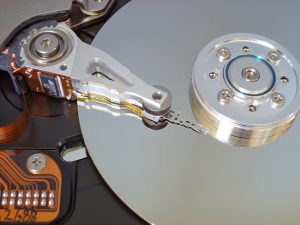
What’s The Difference Between Logical Data Recovery & Physical Data Recovery?
 Hard drives work in amazing ways. If you’ve ever had a hard drive failure message pop up on your screen, you know how scary it can be to think that your files may be corrupt and lost forever. Many people store important documents, precious photos, and other valuable files electronically, so when your hard drive fails it is natural to feel slightly panicked. Fortunately, however, more times than not files can be recovered even if you are dealt the dreaded “catastrophic error” message.
Hard drives work in amazing ways. If you’ve ever had a hard drive failure message pop up on your screen, you know how scary it can be to think that your files may be corrupt and lost forever. Many people store important documents, precious photos, and other valuable files electronically, so when your hard drive fails it is natural to feel slightly panicked. Fortunately, however, more times than not files can be recovered even if you are dealt the dreaded “catastrophic error” message.
Hard drives can experience two kinds of damage, physical and logical. In short, physical damage occurs when the electronic mechanisms inside your hard drive are damaged to the point that they no longer work or your computer cannot read them. On the other hand, with logical damage, the hard drive’s hardware components are working properly but the file cannot be accessed or read by your computer due to software corruption. For both types of hard drive damage, computer data recovery can be achieved in most cases using specialized equipment.
Because data recovery varies depending on which type of damage your hard drive was exposed to, it is important to know the signs of each so that you can diagnose the problem. Read on for more information compiled by a Brisbane HDD data recovery service about the differences between logical and physical hard drive damage and data recovery.
What is Physical Damage and What Causes It?
Physical hard drive damage occurs when the internal mechanisms of your hard drive fail. This type of damage can cause file corruption and even permanent loss if the damage affects the specific sectors where your files are stored. Physical damage can occur from a wide range of factors like a fire or flood, faulty electronic parts, a head crash, or even being dropped.
If you’ve ever heard a strange buzzing, grinding, or clicking sound emitting from your hard drive, it has likely experienced physical damage. This type of damage is especially common with external hard drives, USB drives, and portable discs as they can easy be dropped or bumped around; however, this type of damage can also occur in your computer.
One of the most common, and also most risky, causes of physical damage is a head crash. This type of damage occurs when the read-write head is jolted out of place and presses against the rotating platter, causing severe and often permanent damage. Head crashes are also common when users try to repair their hard drives themselves but do not have a clean space—thereby causing dust particles to interfere with the device which can result in a head crash.
Because there are many different electronic components inside of a hard drive, there can be many causes for the malfunction. In most cases, the only way to determine what is causing the corruption is to physically open your hard drive in a clean space and inspect the components. If you suspect your hard drive may be suffering from physical damage, it is advised not to attempt to use it again until it has been inspected and repaired, as this can cause even more severe complications.
Physical Data Recovery
To achieve hard drive recovery after physical damage has been suffered, you will need to open your hard drive, inspect its components and replace any damaged parts. This process can be very delicate, as you need a specialized clean room that is dust, dirt, and static-free, as even the smallest particles can get trapped in your device and cause even further severe damage. In some cases, specialized equipment may also be needed to remove certain components from your device carefully without damaging any other parts.
One mistake that many make when they attempt to repair physical damage on their hard drives at home, is that they try to replace damaged PCBs with identical ones from working devices. This method may work in some rare cases, but for most hard drives created after 2003, you will actually need a replacement board to achieve data recovery. This is because newer PCBs contain adaptation data and other information that is drive-specific, and therefore you cannot simply replace it with the PCB of another device.
When you send your drive to a computer data recovery laboratory, specialists will open your hard drive in a controlled environment and replace any broken components. In some cases, this type of repair may be enough, but it is also common that your drive may need to undergo logical damage repair as well before you can achieve maximum data retrieval. The most common hard drive recovery technique involves using a disk-imaging process that will copy every readable bit from your drive onto a reliable medium. After this recovery, the image will undergo analysis to determine existing logical damage for possible reconstruction and repair.
What is Logical Damage and What Causes It?
As opposed to physical damage which effects the hardware mechanisms/components inside your hard drive, logical damage affects its software. With this type of damage, files become unreadable due to issues like damaged file systems or partitioned tables, or it can be caused by logical bad sectors and intermittent media errors. Other common causes of logical damage occur when system data is deleted, formatted, or lost from the drives. This can accidentally occur due to human error or it can be a result of a virus attack.
Logical hard drive damage is often detected when you try to access a file and get an error message stating that the file is corrupt. If you have every tried to open an image, for example, and found that part or most of the file was black or covered in multi-colored lines, this is a sign of logical damage.
In many cases, software can be used to rewrite system files and reformat your drive for data recovery. This type of damage can often be reversed and a portion, if not all of the data can be retrieved.
Logical Data Recovery
 To achieve logical data recovery, you will typically need to use a specialized data recovery software to restore the file. While there are some user-software on the market, it is best to seek professional laboratory grade data recovery services, unless you have experience in data retrieval, as misdiagnosing the problem can cause irreversible damage to your drive.
To achieve logical data recovery, you will typically need to use a specialized data recovery software to restore the file. While there are some user-software on the market, it is best to seek professional laboratory grade data recovery services, unless you have experience in data retrieval, as misdiagnosing the problem can cause irreversible damage to your drive.
One of the most common causes of logical hard drive malfunction is due to logical bad sectors. In the event of a logical bad sector, your drive will not be able to access your files from the bad sector of the media drive on which the files are stored. To resolve this issue, the first step is typically to try to correct the bad sector using software, but if that does not work, you may need to replace certain hardware components to restore access to the media drive.
Additional Data Retrieval Techniques
In some cases, severe damage to your drive requires additional data retrieval techniques to restore your files to normal. After repairing any hardware components, many computer data recovery labs will use a disc imaging technique to clone as much readable data from your drive as possible and store it on a separate medium. This image can later be analyzed to determine logical damage, and software can be used to try to repair any system errors. In many cases, this will be enough to retrieve most, if not all, of your data so that you can back it up on a new drive if desired.
However, in some cases, this damage to your drive may be so severe that additional data recovery steps will be required. For example, if the data recovered is still corrupt, specialized software may be used to try to reconstruct the file so that it is readable again.
Preventing Physical and Logical Failure
While physical and logical data recovery affect different aspects of your hard drive and therefore require different solutions, it is still important to treat them with equal caution to prevent additional damage. Whether you are using a computer, external hard drive, USB, or any other type of memory storage, it is important to treat it with care so that the internal components do not accidentally get jolted out of place. Keeping your devices clean will also prevent dust and other particles from getting trapped in your device, and installing malware protection can prevent a virus does not attack your system files. Why not read a little more on ways to avoid costly data recovery.
What to do When Physical or Logical Damage Occurs
The most important thing to do when physical or logical failures occur is to not try to access corrupt files again and again. Many people panic when they realize their hard drive is crashing and they rush to recover as many files as possible. By doing this, however, you are placing additional strain on your device and possibly exposing it to further damage as files can become even further corrupt if your drive is unable to access them. In cases like these, it might be best to hire a professional hard drive data recovery technician. The best thing to do when hard drive malfunction occurs is to power off your device, identify which type of damage is present, and seek a professional to help you recover your data in the most delicate and efficient way so that your files are not permanently lost. If you feel you are willing to take on the risks of recovering your own data, there are many methods for doing this. Please always consult a professional when your data is valuable to you.
